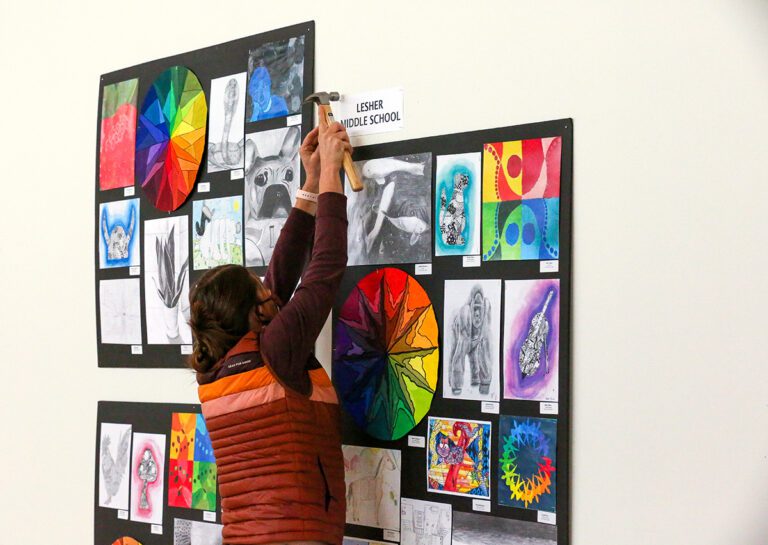What if you didn’t need to advocate for the arts? What if everyone agreed the arts are an essential part of education, culture, and life?
These are questions I think about regularly, and in order to answer them, I’ve been exploring how we can make advocacy a simple and routine part of our lives.
Join the challenge to take one small action every day to advocate for the arts.
1. Share an artist’s work on social media.
Find an artist you love and share their work on your favorite social media platform. When sharing other’s work be sure to give proper credit to both the artist and the photographer.
If you can’t think of an artist, here are some for you to explore.
- 11 Fascinating Jewelry Artists to Share with Your Students
- 10 Inspiring Ceramic Artists to Share with Your Students
- 10 Inspiring Fiber Artists You Should Know
- 10 Photographers Your Students Will Love
2. Pin 5 works of art you love.
You can go directly to Pinterest and pin from existing content. Or, go to an artist’s website and pin directly from their site. Pinning directly from the artist’s site helps to make sure traffic is sent back, allowing people to find out more about the artist and purchase their work.

3. Pin 5 videos about art.
Not only does this help to build your resource library, but it also helps others to discover great content.
4. Listen to an art-related podcast.
While you’re driving to work, over your lunch period, or during your prep period, listen to an art-related podcast. Then leave a review. The more reviews a podcast receives, the easier it is for others to find.
Here are a few to get you started:
5. Share an art-related article.
Find an art-related article you enjoyed reading and share it on your favorite social media platform. Make sure to tag the author.
6. Subscribe to art-related YouTube channels.
Brainstorm a list of YouTube channels you use for resources or ideas in your art room. Take a few minutes to make sure you’ve subscribed to those channels. Not only does this make it easier for you to know when they release new content, but it also helps to grow their audience.
If you’re having trouble thinking of channels here are a few:
7. Watch a video.
As you watch videos on YouTube you like, make sure to take a moment to give them a thumbs up.
8. Read a book.
Think about an art education or art-related book you read and enjoyed. Find the book on Amazon and leave a review.

9. Recommend a book.
Tweet or share on Instagram the title and author of one of your favorite art-related books. Make sure to also tag the author.
10. Leave a review.
Leave a review on Yelp for your favorite gallery or museum.
11. Watch a movie.
Watch an art-related documentary on Netflix or Amazon Prime, and make sure to give it a thumbs up.
12. Recommend a movie.
Remember the movie you watched recently? Share the name of the movie and why you loved it on social media.
13. Talk about art.
Get your school talking about art. Have your students ask ten people outside their class why they think art matters. Make sure to have students write down the answers. This assignment will spark interesting and powerful conversations.
14. Make posters.
Have your students take their favorite responses about why art matters and turn them into posters to hang around the school. Or, make them into images to share on social media.
15. Talk about money.
Teach your students how to price art. When students understand how art is priced, it allows them to be smarter consumers.
16. Attend a craft show.
Make a plan to attend a craft show. Start by checking to see if there is a guild in your area that holds a show. Next, explore the American Craft Council, and see if they have a show near you.
17. Make plans to engage with art.
Look at your calendar for the next month and make a plan to attend a conference, a local art event, take an art class, or go to a gallery or museum. Bonus points: Share your plan on social media.
18. Donate.
Donate to your favorite arts organization. Even if it’s only $5.00.
19. Craft an elevator pitch.
Take time to draft an elevator pitch sharing why art matters. If you’re having trouble getting started read, How to Craft an Effective Elevator Speech for Your Art Program. Bonus points: Share your elevator pitch in an Instagram story.
20. Extend an invitation.
Invite an administrator or board member to participate in your art class.
21. Share your “why.”
Using your favorite social media platform, share why you became an art teacher.

22. Leave a comment.
Find five art-related social media accounts and take a moment to leave a comment on something you enjoy.
23. Pin 20 items.
Find your favorite art teacher account on Pinterest and re-pin twenty things from their boards to yours. This gives you new ideas while also helping others to find the content.
24. Make art.
Take fifteen minutes to create art just for fun. Remembering how good it feels to create helps to remind us why art matters. Take it a step further and share your process with your students.
25. Find an event.
Find a local art event on Facebook and share the event page to bring awareness to others in your community.
26. Talk about art careers.
Work with your students to brainstorm a list of art-related careers. Post the list in your classroom, throughout your school, or share on social media.
27. Explore local artists.
Create a list of local artists and teach your students about them. Take it a step further and invite the artists to visit your classroom.
28. What would exist without artists?
Have your students brainstorm what would still exist if there were no artists or designers in the world. Hint: The list is short.
29. Talk about visiting an art museum.
Many people don’t go to art museums because they find them intimidating. Talk to your students about visiting art museums. To help with the conversation have students watch the video, “How to Visit an Art Museum,” or, ” The Case of Museums,” created by The Art Assignment.
30. Comment on museum and gallery sites.
Find your favorite museum or gallery on your preferred social media platform and leave a comment.
31. Buy art.
Look ahead for upcoming holidays and birthdays, and commit to buying from artists. Something as simple as buying a card makes a difference.
We all agree art advocacy is important. But we often feel like we don’t have the time. While large events like art shows are valuable, small daily actions can leave a significant and lasting impact as well.
What’s the most creative way you’ve advocated for the arts?
What is one way to advocate for the arts you think should be added to this list?
Magazine articles and podcasts are opinions of professional education contributors and do not necessarily represent the position of the Art of Education University (AOEU) or its academic offerings. Contributors use terms in the way they are most often talked about in the scope of their educational experiences.






